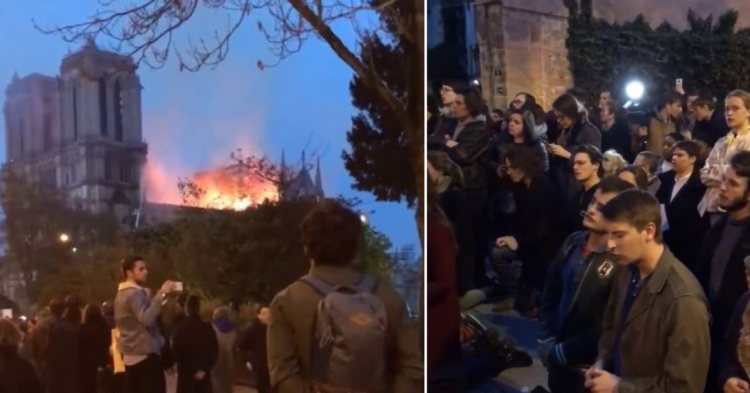You don’t expect to wake up on a random Monday and witness a major historical event, but that’s just what happened on Monday, April 15, 2019. The iconic Notre-Dame de Paris cathedral was hit by a major fire — but it’s the human side of this event that’s truly remarkable.
The cathedral is seriously historic.

Construction on the cathedral started in the medieval period and wasn’t consecrated as complete until 1345 — nearly two centuries after building started. The remarkable building features two towers that soar more than 200 feet high.
It’s been there for most of France’s history.

From medieval times to the Renaissance to the French Revolution and a pair of world wars, Notre Dame has stood tall in the center of Paris for more than eight centuries.
In 2019, everything changed.

The cathedral caught fire at about 6:30 pm local time. Extensive renovations had been in the works for some time before the fire, and it’s believed they may have had something to do with it.
It was a devastating fire.

While the cathedral’s exterior walls are made of stone and therefore somewhat fire-resistant, the flames ripped through the building. Eventually, the roof of the main cathedral gave way and collapsed.
The spire fell.
As the crowd gasped, Notre Dame’s tallest point — a spire that’s visible all around — was toppled by the flames as its debris fell into the inferno below.
It’s an emotional scene.

A cathedral like Notre Dame is, at its most basic, a place to worship. For devout congregants, it’s devastating to see their church — or at least a church affiliated with their beliefs — burn.
There’s also the historical value.

Even for an atheist, there’s something jarring about seeing a long-lasting monument simply give way to the fire and flames. It seems like centuries of history have evaporated in an instant.
Notre Dame will recover.

It’s been beaten up before, notably during the French Revolution and both world wars, and the exterior components of the cathedral have been saved. Unfortunately though, it’ll take some work to build a new spire and roof.
Parisians reflected.

The massive fire drew onlookers from the afternoon into the evening. But as the firefighters worked to contain the flames, a more quiet kind of reflection seized the crowd.
The crowd sang “Ave Maria”.

In a beautifully impromptu moment, the crowd sang this gorgeous song. A video of the haunting song was posted to Twitter by Ignacio Gil . The song is perfectly poignant given the circumstances.
It translates to “Hail Mary”.

Stemming from the Lord’s Prayer, the most well-known version of Ave Maria is the soaring version penned by Charles Gounod in 1853. As Gounod was a well-known French Romantic composer, it seems to be the perfect song.
It was beauty amid tragedy.

The song itself is beautiful. But the most stirring part of this is the way a group of people, presumably mostly strangers to one another, found comfort in song during a dark time.
It brought comfort.

The lyrics of Ave Maria, though they’ve been modified at times, are essentially a humble Catholic prayer. They call for Mary’s blessing and reassure the listener that God is with them.
It’s an iconic lens to view the event through.

Some things just stick with you — and the burning of a centuries-old historic cathedral juxtaposed against a group of onlookers finding comfort through song is certainly an incredible scene.
Did you watch the cathedral burn?

Whether you’ve been to Paris or not, it was quite a sight. Make sure to share your thoughts in the comments section, and when you’re done, check the video below.



















































